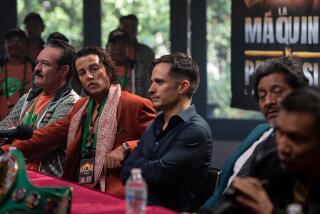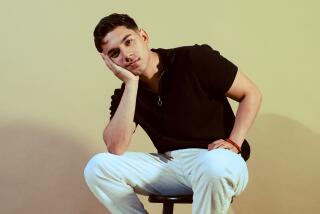INSIDE ‘TANGO ARGENTINO’
In a flood of volcanic Spanish, tango master Hector Mayoral is defining for an uncomprehending gringo interviewer the essence of the dance culture expressed in “Tango Argentino,” the Tony-nominated compendium of songs and dances that opens May 20 at the Pantages Theatre.
Leaning forward, eyes flashing, Mayoral speaks enthusiastically, expansively in extended, almost musical cadences that are accented with authoritative slaps on the table and interrupted briefly by an exchange of words--and an explosive laugh--with his wife and dance partner, Elsa Maria.
Finally, as if disclosing the deepest secrets of the tango art, Mayoral lowers his voice to an urgent hush, delivers what seems to be a definitive verbal/gestural flourish and shoots a confident glance at Hector Orezzoli, Tony-nominated co-director (with Claudio Segovia) of the show. Everyone smiles expectantly.
“He says,” Mayoral’s translator murmurs sweetly, “it is a feeling difficult to put into words.”
Indeed it is: In tango dancing and in “Tango Argentino,” everything may be explicit, but nothing is ever explained. Thus even a full translation of Mayoral’s remarks ultimately reveals only a little more about tango culture than he conveys through the physical style and passion of his speech, his spontaneous body-Spanish.
To Mayoral, “Tango is something natural that you must feel and you can’t judge it. Someone can be very perfect and technical but if you do not get the feeling, you will say ‘That is not tango.’ ”
“There is no choreography,” Elsa Maria adds. “It’s a language. The men improvise all the steps and they push the lady with their chests.”
“Everything is inside,” Mayoral emphasizes. “I feel like a bullfighter when I am dancing. Nothing is physical pleasure. The passion of tango has never been physical. When I once taught tango to American women, and they would look into my eyes when I held them close, I couldn’t go on--because they were thinking of something else than tango.”
An authentic tango dancer from the barrio of Buenos Aires, Mayoral taught the tango to the ballet-trained Elsa Maria 20 years ago and they soon danced together in tourist shows before forming their own small company. Icons of the elegant, deceptively simple-looking salon-tango style, they complement six other couples in the historical/stylistic cavalcade that “Tango Argentino” represents.
Beginning with examples of the early, intense tango-of-the-brothels, the show grows cooler yet more virtuosic as the dancers trace the evolution of tango technique and the inevitable taming process accompanying the dance’s emergence as a cafe-society export item decades later.
Although reflecting changes of era and social context, the costumes remain black, white and silver--a concept that reinforces the severity of tango style and, like the use of a single group of musicians (the Sexteto Mayor, placed upstage of the dancers), helps unify the production.
Midway through, the show briefly abandons its exhibition-ballroom (or, if you prefer, folklore documentary) format for a lurid tango dance-drama: an ironic cautionary tale about a woman who attracts too many partners--not all of them male. But even here, as Orezzoli says, the dances themselves are kept undistorted: “The theatrical design comes in the union of the dances, not the dances themselves. The idea is that the dance would lead the story--the woman is led by different dances to her death.”
This melodrama is both true to the bleak tango world-view and not that far from barrio reality. In a community with seven men to every woman, tango competitions have always been highly intense.
“In the barrio, they do not practice with women, so Mayoral learned the tango from other men,” Elsa Maria says. “During the week, the men dance with men to practice up for the weekends, when they go to the ballrooms.”
Mayoral remembers tango competitions ending in fist fights and “there are even anecdotes of dancers going to another neighborhood and finishing the dispute with knives,” he says.
This sense of tango-combat survives even in the relatively sedate salon style. “We are all the time fighting,” Mayoral says of his partnership with Elsa Maria, “and we insult each other when sometimes a step doesn’t go right. Some couples don’t even care about the public. I have seen one of the other men (in “Tango Argentino”) fighting onstage with his wife and walking out on her before the music finished.”
Though “Tango Argentino” summarizes the development of one aspect of Argentine popular culture and has inspired worldwide interest in both tango dancing and the performers who still maintain the authentic tango traditions, the show has never been seen in its country of origin. No sponsor was interested.
Orezzoli and Segovia had collaborated on earlier productions featuring folk artists and their decision to do a tango revue in Buenos Aires--”to recover the genre in all its forms,” in Orezzoli’s words--came from a lifelong love of tango culture.
“We adored the very authentic people,” he recalls, and though these artists were no longer young and maintained a following only with aficionados, Orezzoli found them to be “great interpreters and I discovered through them a whole world that was passionate, that had a lot to do with feelings that we wanted to illustrate.
“So we made a script at that time for a tango revue first of all because we loved tango and then because it was a good excuse for us to put together a number of artists, the very authentic people, that we thought were in danger of extinction in the world.
“Nobody accepted the idea. The cultural politics and intellectuals (of Buenos Aires) have never cared about tango because, since the beginning, tango has been always marginal and in the early 1980s it was confined to some nightclubs and cabarets for tourists and one or two radio and TV programs.”
So Segovia and Orezzoli went to Paris--where the tango had first achieved international renown before World War I--and readied “Tango Argentino” for the Festival d’Automne in 1983, working in the Theatre du Chatelet, where Sergei Diaghilev and his company made dance history early in this century.
“In Paris there was a base prepared,” Orezzoli points out, “because some very good (tango) artists had appeared recently and they were very well known. People were prepared for this event. But in America, we came a little bit like an assault.”
The initial U.S. assault came in June, 1985, after “Tango Argentino” had proved itself in two consecutive appearances at the Festival d’Automne, plus engagements at the Venice Biennale, the Vienna Festival and elsewhere in Europe. A sold-out one-week engagement at New York City Center led to a return engagement (on Broadway) and a success that still perplexes Orezzoli.
“When you see the things that are happening on Broadway, you can’t understand something so completely different having such a fabulous success,” he exclaims. “I sometimes stood at the back of the theater and I thought, ‘They are still here at the end of the show and I can’t believe they are still here.’ ”
After the current five-city American tour, there are invitations extending into 1988, including one from the venerable Teatro Colon in Buenos Aires that Orezzoli hasn’t accepted.
“Their values really haven’t changed toward the tango or anything that is authentic or identifies us,” he declares. “We would like to do it (in Buenos Aires) but not in an official theater for an elite that doesn’t understand and has never been interested in this kind of artist.”
Although tango has been in decline since the ‘50s, when American pop music came to dominate Argentine entertainment, it is still a living form of cultural expression. In 1986--a century after Argentina first heard the bandoneon (the resonant, accordion-like instrument that quickly became the focus of tango music)--the tango has, in Orezzoli’s words, arrived at “a kind of synthesis. It is now almost abstract: the geometry that two dancers create.
“The tango has always expressed deeply and with energy a state of mind or mood about Buenos Aires,” he continues. “And right now it expresses a neurotic, alienated attitude and seems very cold, merely the elaboration of choreography. But underneath there is still the nostalgic and decadent feelings that have always been there.”
More to Read
The biggest entertainment stories
Get our big stories about Hollywood, film, television, music, arts, culture and more right in your inbox as soon as they publish.
You may occasionally receive promotional content from the Los Angeles Times.










